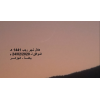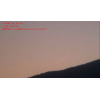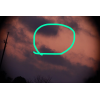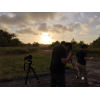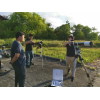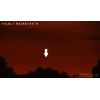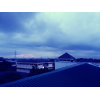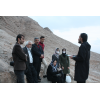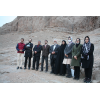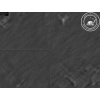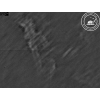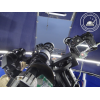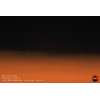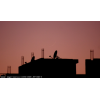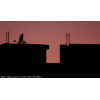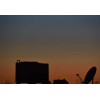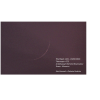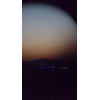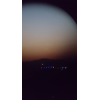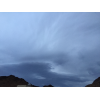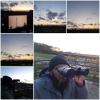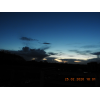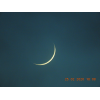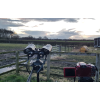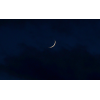Visibility of Rajab Crescent 1441 AH
- When to Observe Rajab Waxing (NEW) Crescent ?
- Rajab Waxing (NEW) Crescent Observation Results
- The OFFICIAL First Day in Different Countries
- When to Observe Jumadal Al-Aakherah Waning (OLD) Crescent ?
- Jumadal Al-Aakherah Waning (OLD) Crescent Observation Results
When to Observe Rajab Waxing (NEW) Crescent ?
The geocentric conjunction (Geocentric New Moon) will occur Inshalla on (Sunday 23 February 2020) at 15:32 UT.
Sighting the new crescent on (Sunday 23 February 2020) and (Monday 24 February 2020) is shown in the below graphs using the program Accurate Times by Mohammad Odeh according to Odeh criterion. Where:-
- It is impossible to see the crescent from the areas located under the red color. Because either the Moon on this day sets before the Sunset and/or the topocentric conjunction occurs after the Sunset.
- The crescent is expected to be seen by optical aid only from the areas located under the blue color.
- The crescent is expected to be seen by optical aid from the areas located under the magenta color. In these areas the crescent could be seen by naked eye if the atmospheric conditions are superb and the observer is experienced.
- The crescent is expected to be easily visible by naked eye from the areas located under the green color.
- The crescent cannot be seen from uncolored areas, even though the Moon sets in these locations after the Sunset and the topocentric conjunction occurs before the Sunset, but the Moon is not sufficiently illuminated in order to be seen as crescent even by optical aid.
- Kindly notice that the below graph shows the possibility of seeing the crescent from areas between 60 degrees north of Equator down to 60 degrees south of Equator.
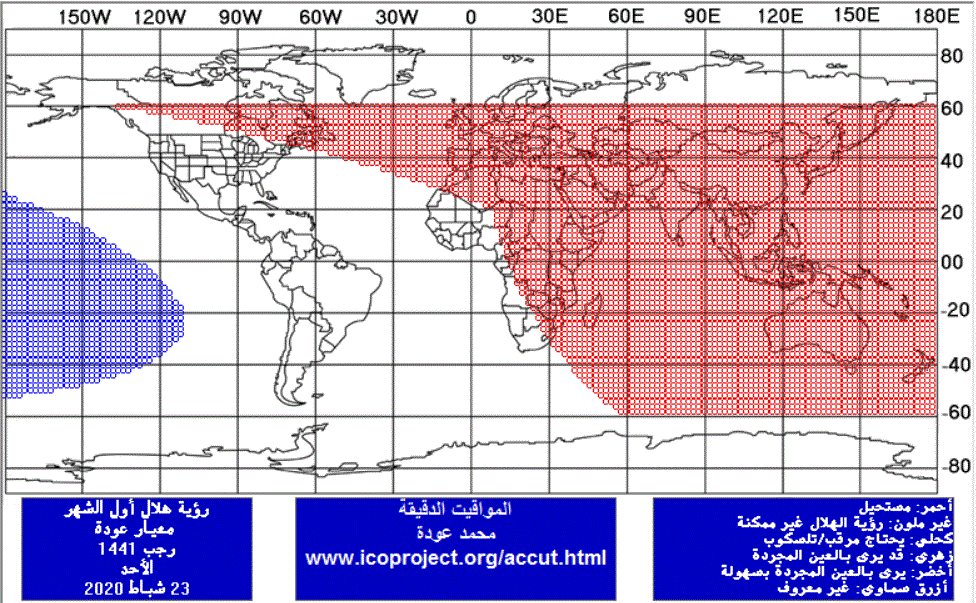

According to the Universal Hejric Calendar (UHC), which is based on the calculated crescent visibility, the start of this month in the Eastern Region will be on Tuesday 25 February 2020 and in the Western Region will be on Tuesday 25 February 2020. Kindly notice that the UHC is a pre-calculated calendar, which adopts a certain criterion to start the new Hejric month. Your country/organization might adopt different criterion to start the new Hejric month. So it is highly advised to read the UHC website before giving any judgment.
- Results of seeing the crescent, and the first day of the month in different countries will be added here Inshalla as we receive the reports from ICOP's members. If you wish to be a member in ICOP, or to know more about it, kindly click here.
Rajab Waxing (NEW) Crescent Observation Results
Mon 24 February 2020
Algeria
Mr. Abdellatif Fareh said: "تمكن أعضاء النادي الفلكي بكوينين ولاية الوادي من رؤية الهلال بالعين المجردة بعد الاستعانة بالمنظار."
Mr. Banouh Nouh Mefnoune said: "بسم الله الرحمٰن الرحيم والصلاة و السلام على سيدنا محمد وعلى آله و صحبه ومن والاه. أما بعد، فقد تمكن أعضاء من محضرة الشيخ أبي العباس أحمد الوليلي رحمه الله و جمعية أمنير الفلكية (بني يسجن) من رؤية هلال رجب هذا الإثنين بعد غروب الشمس بالعين المجردة ابتداءً من الساعة 19:00، وكانت السماء صافية و الجو ربيعي معتدل والحمد لله، ظهر الهلال خافتا جدا على يسار مغرب الشمس يبعد عنه بأصبعين مع مدّ الذراع (حوالي أربع درجات) ويعلو الأفق بنفس المقدار، مشيرا بقرنيه بالتقريب إلى الساعة الثالثة والسابعة، وبقي ظاهرا إلى غاية غروبه على الساعة 19:23، وشوهد كوكب الزهرة قبل رؤية الهلال عند غروب الشمس، وتم رصد وقت العشاء بعد غروب الهلال وهو غروب الشفق الأحمر الذي كان تقريبا على الساعة 19:42. وقد تم تأكيد رؤية هلال رجب بالعين المجردة من أماكن أخرى في غرداية والحمد لله، و عليه فستكون هذه الليلة إن شاء الله ليلة الثلاثاء الفاتح من رجب ١٤٤١ هـ، ندعو المسلمين لإحيائها بمختلف العبادات، اللهم بارك لنا رجب و شعبان وبلّغنا رمضان."
Dr. Younes Rakour said: "المعطيات الفلكية ليوم 24 فيفري / شباط 2020 غروب الشمس : 18:26 غروب القمر: 19:15 الإضاءة : 1.1% الإستطالة: 12° الإرتفاع عن الأفق : 8° تمت رؤية الهلال بعد الإستعانة بمنظار ذو تكبير 20x بعد غروب الشمس بـــــــــــــــ 30 دقيقة "
Australia
Brunei Darussalam
Mr. Hazarry Haji Ali Ahmad said: "The western sky was very cloudy and windy. Venus and the Sun were used to align the telescopes. The crescent was sighted at 1903 local time when there were gaps between the clouds about 2 degrees above the horizon. The observation was conducted by the members of the Astronomical Society of Brunei Darussalam."
Ghana
Mr. Abdul-Aziz Anyang said: "Though we were expecting the Hilaal (New Crescent) to be seen as moon age after conjunction is 26 hours and more after our sunset time of 18:14 GMT. As at now i have not receive any moon sighting report from all the regional capitals of Ghana and hence we will be counting tomorrow Tuesday February 25, 2020 as the 30th Day of Jumada Thaani as per the sunnah requirements."
Hungary
Indonesia
Mr. ِِِArwinjuli said: "Assalamualaikum, Rajab Crescent Observation Report Observatorium Ilmu Falak UMSU Date: 2020 - 02 - 24 Equipments: Telescope GT102,QHY 5-II M + IR filter. Results: Moon crescent was seen by telescope and CCD. Observers: 1.Arwin Juli Rakhmadi Butar-butar 2.Hariyadi Putraga 3.Muhammad Hidayat 4.Marataon Ritonga"
Mr. AR Sugeng Riyadi said: "The new crescent of Rajab 1441 was not seen on Monday, February 24, 2020 from my location at Rowasiya Observatory in Bendo Ketitang Juwiring Klaten Central Java. My students of CASA (Club Astronomi Santri Assalaam) also tried to observe the moon at Assalaam Observatory, the crescent was not sighted even by CCD. The sky was very hazy and cloudy. The moon was sighted from Barru, South of Sulawesi by BMKG Team and also from Medan, North of Sumatera by OIF UmSu Team. The 1st of Rajab 1441 in Indonesia started on Tuesday, Feb 25, 2020."
Iran
Mr. Hossein Janghorbani said: "In the name of God Rajab Crescent Observation Report The Astronomy and Geophysics Center of Shahreza – The Crescent Association of Shahreza Report by: Hossein Janghorbani (NajmoSepehr-Sadrolmonajjemin) – Manager of Shahreza Crescent Association and Red Crescent’s Astronomy and Geophysics Center Date: Monday, 02/24/2020 Location: Damzad foothills in the East of Shahreza (latitude: 32 00 N, longitude: 51 52 E, elevation: 1825m from sea level, time zone: +3.5 GMT) Equipments: Two set of 15*70 binoculars,One compass. Atmospheric condition: totally cloudy Horizon obstacles: about 2.5° Apparent Sunset: --:-- Results: Moon crescent was not seen by binocular. Mr. Reza Jankhorani, located 15 km from Shahreza – Dehaghan Did not see the crescent moon. At the end of this program ,Mr Hossien Janghorbani ,manager of Astronomy and Jeo physics House of Shahreza with 25 years back ground in astronomy science and jeo physics and Natural Geography and Meteorology and Islamic Astronomy and Author of astronomical calendars About Astronomical Calendar Year 1399 Astronomical and Geophysical House of Shahreza Description Provided Observers: 1.AbdolReza Gholami 2.Mostafa Rahmati 3.MohammadJavad Nikeghbal 4.Ali Janghorbani 5.Hossein Janghorbani 6.Shahnaz Soroori 7.Masoomeh Hafar 8.Ziba Hafar 9.Zahra Fallahi "
Iraq
Mr. Hashim Almoosawi said: "بسمه تعالى رصد هلال رجب سنة 1441 بواسطة مرصد البصرة الفلكي https://www.facebook.com/BasraAstronomicalObservatory #Basra_Astronomical_Observatory تمكن المرصد من التقاط بضع صور اولها في الساعة 4:55 عصر اليوم الاثنين و بصعوبة بالغة بسبب الغيوم و الامطار الكثيفة و تم اقتناص الصورة لفترة اقل من 10 دقائق. تلسكوب نوع: ED127 كامرا: Lumenera LT365R فلتر: 742"
Malaysia
Morocco
Mr. Hatim El Harrak said: "تم ولله الحمد رؤية هلال شهر رجب الفرد 1441 هـ مساء الإثنين 29 جمادي الآخرة 1441 هـ الموافق لـ 24 فبراير 2020 م وتم رؤيته كذلك وتصويره بكاميرا كانون 500D بعدسة 300-m70 وبالتالي ففاتح شهر رجب الفرد هو غدا الثلاثاء 25 فبراير 2020 م "
Mr. Abdessamad Doukkane said: "تقارير مختلف المدن كانت الرؤية ممكنة وتم تصوير الهلال، وقد شهدت بعض مدن الأقاليم الجنوبية عاصفة رملية"
Eng. Zakaria Guelzim said: "تم رصد هلال شهر رجب بواسطة التلسكوب المجهز بكاميرا CCD ، المثبت في مرصد جامعة الأخوين في إفران وتم التحكم فيه عن بعد من مدينتي طنجة (عزيز كعواش) والرباط (زكرياء كلزيم) (Remote Observatory) كما أعلنت وزارة الأوقاف والشؤون الإسلامية المغربية أن فاتح شهر رجب هو يوم الثلاثاء 25 فبراير 2020"
Mr. Walid Jadar said: "تمت رؤية هلال بصعوبة بالعين المجردة في تمام الساعة 19:30 كما تمت رؤية في عدة مناطق مغربية كوجدة و طنجة ..."
Nigeria
Mr. Simwal Jibril said: "The weather was mostly hazy in most part of Nigeria but the crescent was seen at Nguru and Machina both locations are in Yobe state north East Nigeria"
Oman
Prof. Mohammed Al-Bussaidi said: "The crescent Moon was seen by telescope and by telescope + camera"
Saudi Arabia
Mr. Sami Al-Harbi said: "منطقة المدينة المنورة تتعرض هذا اليوم الاثنين ٣٠-٦-١٤٤١ الموافق ٢٤-٢-٢٠٢٠ لحالة جوية حيث انتشار واسع للسحب مما ادى لحجب رؤية هلال رجب ١٤٤١"
South Africa
United Kingdom
Eng. Qamar Uddin said: "The York weather was temperamental today. It started with snow in the morning, sunshine during the day and ended with partly cloudy in the evening. There was a bank of clouds low on the western horizon (about 3° high) but otherwise clear above the horizon. However, the crescent moon (hilal) was not seen (with either binoculars or naked eye), as it was very close to the horizon after sunset (see attached photos)."
Tue 25 February 2020
United Kingdom
Eng. Qamar Uddin said: "Once again, the York weather was intermitted. It was partly sunny and partly cloudy with hailstone raining during the day. Nevertheless, I went to a good location about half-hour before sunset (17:00 GMT) and waited for the clouds to move until I saw a glimpse of the sun before it set behind clouds. I then set-up my binoculars and zoom camera before praying Maghrib after sunset. As soon as I finished the Maghrib prayer, I turned around and saw the crescent moon (Hilal) by naked-eye at 17:46 GMT near the sunset position but high up in the sky before it was covered by the clouds again. About 15 mins later (18:00 GMT), the Hilal appeared again, above a bank of clouds and I was able to take photographs with my zoom camera, Alhmadulliah (see attached). I have a also recorded a short video of my observation, which you can see from the link below, with the Prophetic supplication (Masnoon Duaa) of sighting the Rajab Hilal (اَللّهُمَّ بَارِكْ لَنَا فِى رَجَبَ وَ شَعْبَانَ وَ بَلِّغْنَا رَمَضَان). YouTube link here: https://youtu.be/drlwOIJwGN0."
Mr. Mohammad Baig said: "Easily seen once the cloud gave way"
The OFFICIAL First Day in Different Countries
Tue 25 February 2020
1 . Algeria
2 . Brunei Darussalam
3 . Indonesia
4 . Iran
5 . Morocco
6 . Nigeria
7 . Oman
8 . Saudi Arabia
9 . South Africa
10 . United Arab Emirates
11 . United Kingdom
Wed 26 February 2020
1 . Australia
2 . Ghana
When to Observe Jumadal Al-Aakherah Waning (OLD) Crescent ?
The geocentric conjunction (Geocentric New Moon) will occur Inshalla on (Sunday 23 February 2020) at 15:32 UT.
Sighting the OLD crescent on (Sunday 23 February 2020) and (Saturday 22 February 2020) is shown in the below graphs using the program Accurate Times by Mohammad Odeh according to Odeh criterion. Where:-
- It is impossible to see the OLD crescent from the areas located under the red color. Because either the Moon on this day rises after the Sunrise and/or the topocentric conjunction occurs before the Sunrise.
- The crescent is expected to be seen by optical aid only from the areas located under the blue color.
- The crescent is expected to be seen by optical aid from the areas located under the magenta color. In these areas the crescent could be seen by naked eye if the atmospheric conditions are superb and the observer is experienced.
- The crescent is expected to be easily visible by naked eye from the areas located under the green color.
- The crescent cannot be seen from uncolored areas, even though the Moon rises in these locations before the Sunrise and the topocentric conjunction occurs after the Sunrise, but the Moon is not sufficiently illuminated in order to be seen as crescent even by optical aid.
- Kindly notice that the below graph shows the possibility of seeing the crescent from areas between 60 degrees north of Equator down to 60 degrees south of Equator.
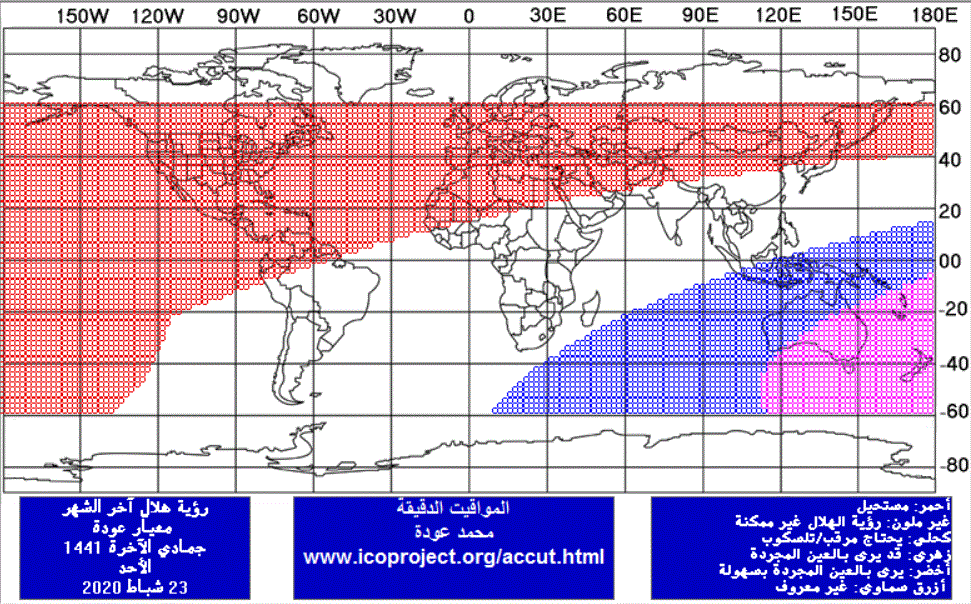
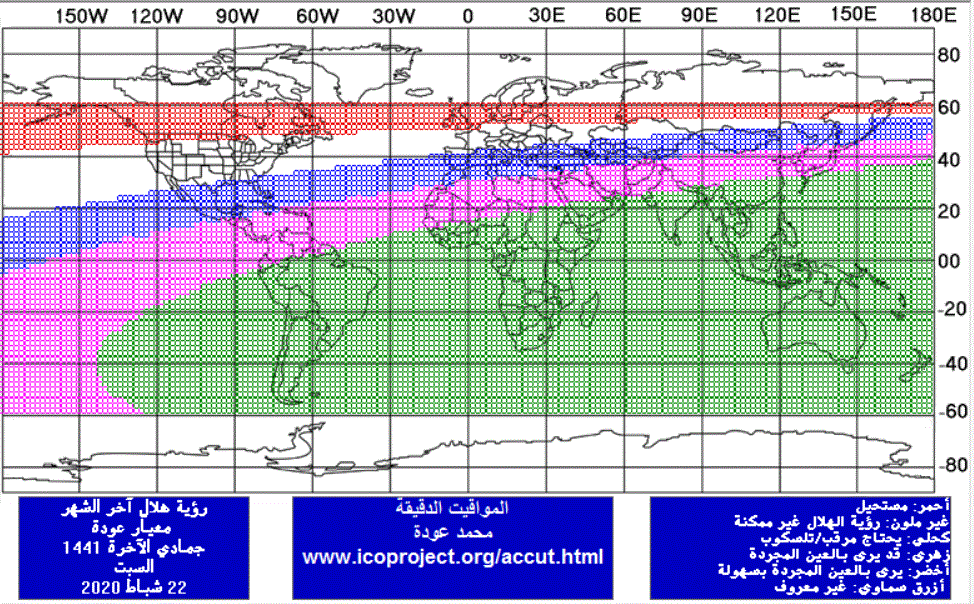
Jumadal Al-Aakherah Waning (OLD) Crescent Observation Results
Sat 22 February 2020
Indonesia
Mr. AR Sugeng Riyadi said: "The sky was totally cloudy, the old crescent of Jumadal Tsaniyah 1441 AH was not sighted on Friday, Feb 22, 2020 from Rowasiya Observatory at Bendo Ketitang Juwiring Klaten Central Java Indonesia."
